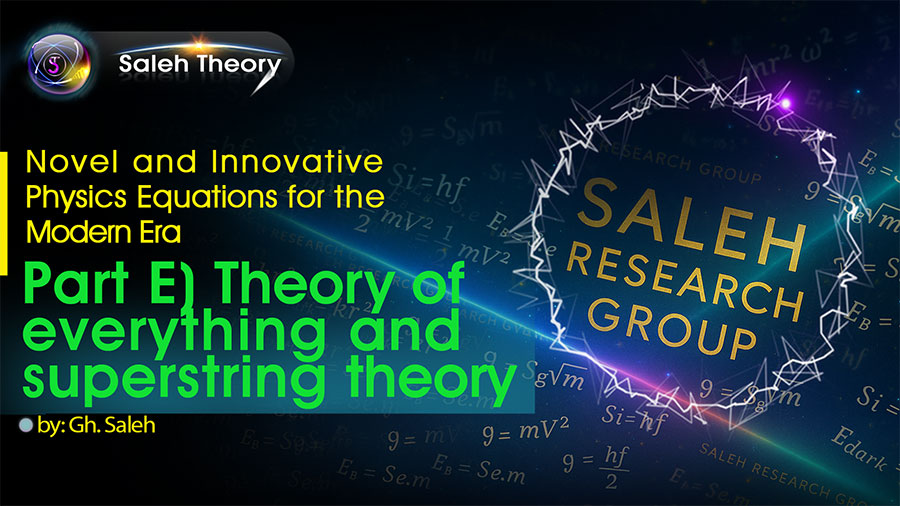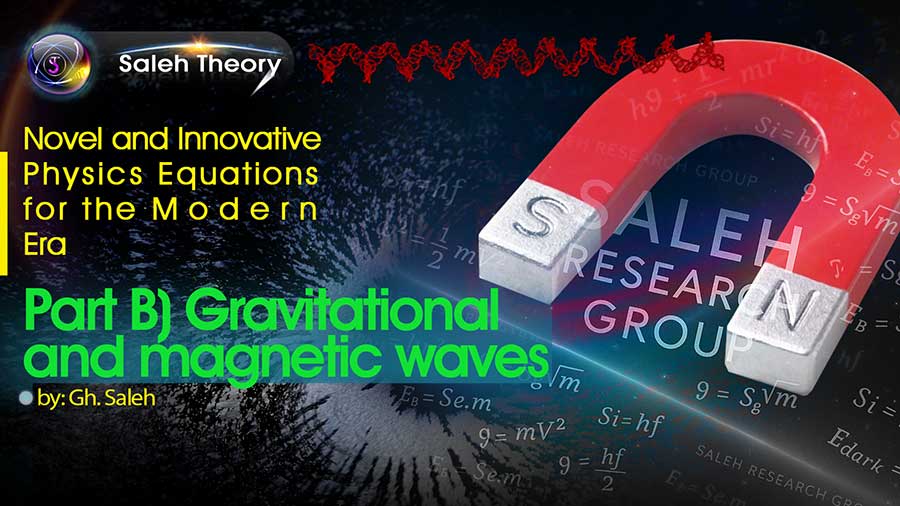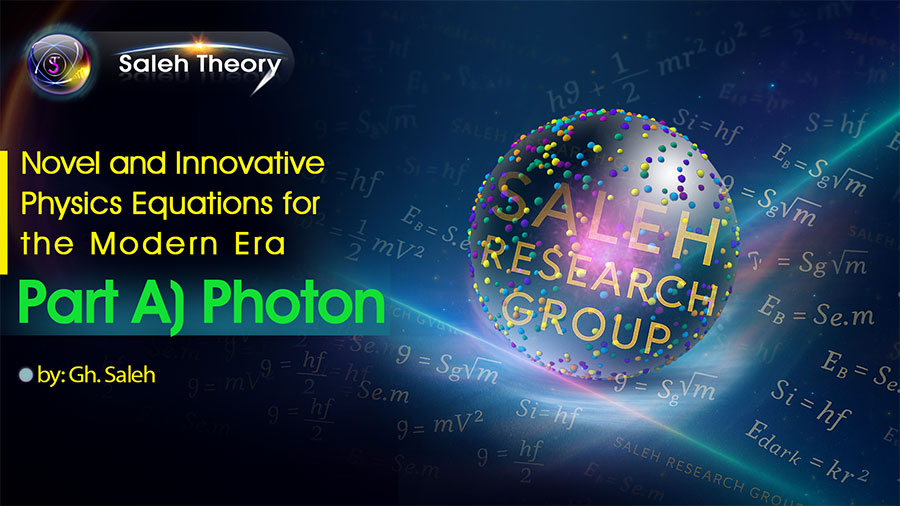
Novel and Innovative Physics Equations for the Modern Era
Part A) Photon
The photon is the lightest, fastest, and most agile particle known in the universe. Although it cannot be seen directly, it is the key factor behind the visibility of all objects. According to the theories proposed by the Saleh theory group, the photon can be considered the cornerstone of the universe—not only because particles such as the electron, proton, and neutron are made from photons, but also because electromagnetic waves are composed of them. Furthermore, even the nature of forces and energies is defined through the photon.
In the following, new equations presented by Saleh Theory on the nature of the photon are introduced.
1. Calculating the radius of the photon helical motion
Since the photon has a helical motion, the radius of rotation of the photon can vary depending on the photon's frequency, and this difference in radius causes the eye to see different colors.
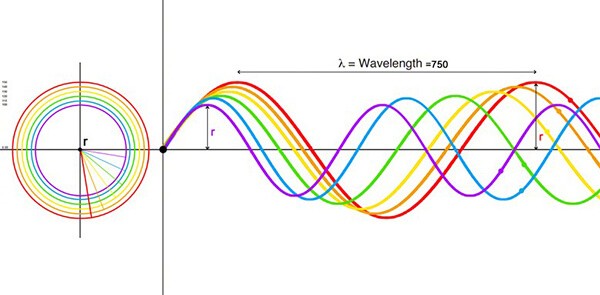
To calculate the radius of gyration, we use the following equation:
Translational kinetic energy = Initial energy - Rotational kinetic energy
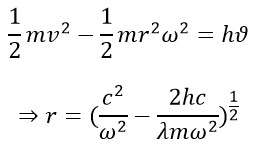
2. Calculating different speeds of photon (linear, wave-like and first, second and third helices)
2.1. The linear speed of the photon vl:
The linear speed of the photon v_lcan be calculated using the following equations:
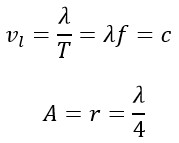
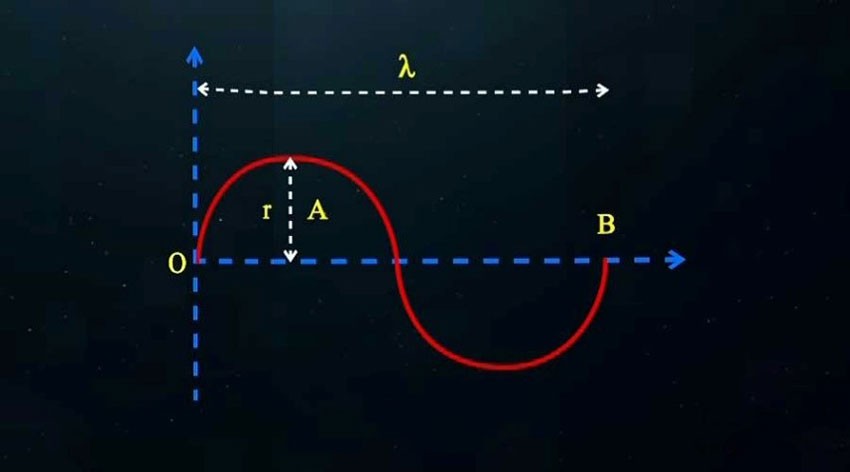
2.2. Speed in curved path:
To calculate the wave path, or the curved path electromagnetic waves, we proceed as follows:
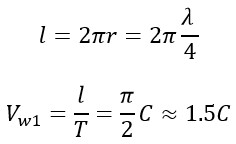
Since the photon is emitted from an electron that has a rotational motion around the atomic nucleus, the emitted photon also has a helical motion.
2.3. Speed in first helix:
To calculate the speed of the photon in its first helix, we use the following equation:
Resultant velocity = Linear velocity + Wave-like velocity
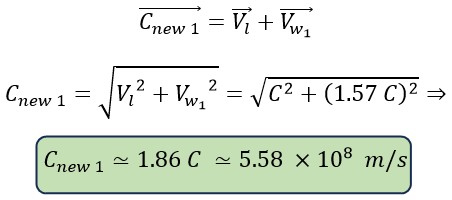
Where the (Cnew 1) is the speed of the photon in the large helix (First Helix), which is the basic and fundamental speed of photon (electromagnetic waves).
2.4. Speed in second helix:
Considering that the electron is rotating around the nucleus of the atom and also rotating around itself, the following figure can be considered for the photon emitted by this electron:

Considering the type of helical motion of the photon in the second helix shown in the figure above, we have:
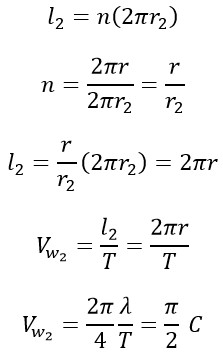
The resultant velocity = The sum of the velocities in the two helical paths + The linear velocity
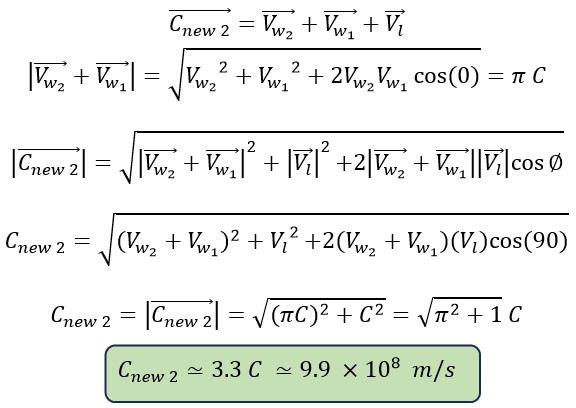
2.5. Speed in third helix
The photon itself also has a rotational motion around itself, which creates a third helix. Using the following equations, this speed can be calculated
Before calculating the speed in the third helix, we first calculate the wave velocity in the third helix.
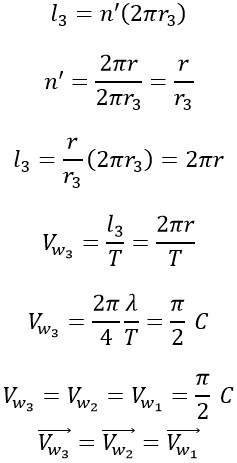
Where “l3” is the traveled distance in third helix, “ n' ” is the number of turns of photon in third helix in one period of big helix (first), “r3” is the radius of third helix and “Vw3” is the rotational speed in third helix.
Similarly, the resultant velocity of a photon (Cnew 3) is equal to the sum of its speed in helical paths and the linear speed. Therefore, we have:
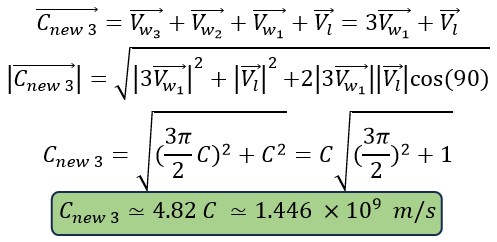
In light of the calculation method where rotational speeds are summed, and their result is added to the linear speed, the following relations can be written for the resultant speed of photon (Cnew m) in “m” helix:
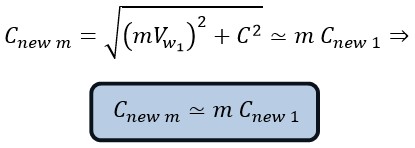
3. Photon energy
One of the most important topics of photon is calculating its energy, which we have, according to the previous contents:

The final energy of the photon is divided into two parts, translational and rotational, and the final energy is equal to the classical kinetic energy of the photon, which is obtained from the following formula:

This energy consists of two parts: rotational energy of photon ER, which depends on the constant angular velocity and the variable rotational radius
The rotational energy of a photon, according to the articles of Saleh Theory, is obtained from the following equation:

To calculate the photon translational energy:

4. Planck-Saleh equation
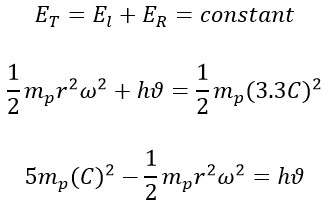
Now, we divide the first equation by the constant ET

We define the two variable parameters as follows:

The following result can be derived from the above equations:

Considering the frequency range of visible light, it can be said that in the frequency range of 300 THz to 900 THz, the range of 𝑖𝑅 𝑎𝑛𝑑 𝑖𝐿 will be as follows:
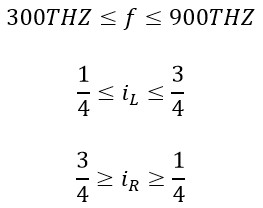
In fact
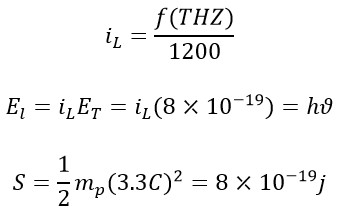
We call the constant value the Saleh constant "S" and rewrite the above equation as follows:

This equation is called the Planck-Saleh equation, where S is the Saleh energy constant and i is a variable coefficient equal to i of L and indicates the variations in translational energy
5. External and Internal Energy of Photon
According to the final speed of photon which is about 4.8 C, the external energy of photon is obtained from the following equation:

According to the articles from Saleh Research Group, the photon is composed of smaller particles called Cidtonium, and when a photon decays, the speed of these particles is equal to the final speed of the photon.
So, the internal energy equals:

Just as a photon has various types of velocity (linear, wave-like, rotational, etc.), Cidtonium can also assume different velocities, and according to the internal structure of photons, different energies can be considered for it.
6. Introducing Photon as the Basis and foundation of Quantum
We can define a basic unit for energy. We can consider photons, because, as shown and proven in the previous articles, photons have a constant speed, a specific mass, and unique properties.
Properties of the Photon:
* Constant mass (mp = 1.64 × 10-36kg)
* Constant total speed (VT = 3.3 C)
If we consider the energy of a photon as the smallest unit of energy, we have:

Given the constancy of this obtained value, it can be considered as the basic and fundamental energy for quantum.
7. Experiments of Michigan university and MIT on electromagnetic waves energy at short distances
According to the experiments conducted by the University of Michigan and MIT on the energy of electromagnetic waves at short distances and observing that the amount of energy calculated by Planck's law is not equal to the amount of energy obtained via their experiments, Sale Research Group has presented the following formula to solve this problem.
According to the Saleh equation, we have:

But at time close to zero (t=ℇ):

Given that the final speed of the photon is 4.8 C, by putting this speed in the photon kinetic energy equation, we have:
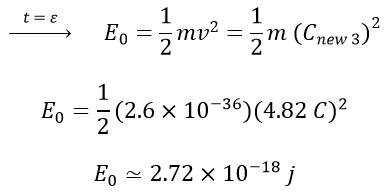
The calculated energy amount is consistent with the results of the laboratories at MIT and Michigan Universities, and the reason for the difference with Planck's equation is that at short distances, energy has not yet been consumed in the photon's rotation, and the energy obtained is greater than Planck's energy.
8. Calculating the angular and tangential speed of photon
To calculate the constant angular velocity (ω) by equating the translational and rotational energy at a frequency of 600 THz. Subsequently, considering the constancy of the angular velocity across all frequencies, we derive a formula to calculate the radius of the rotation of photons (r) in terms of the variable coefficient of rotational energy (iR). Finally, we calculate the rotational radius for several frequencies within the range of visible light.
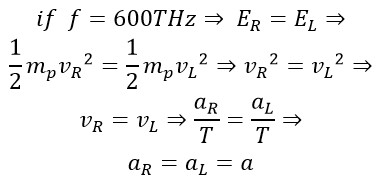
Where aR is the amplitude of rotational motion and a_L is the amplitude in linear motion. The rotational radius is the vector sum of these two perpendicular quantities. Therefore, we have:

At a frequency of 600 THz, the linear amplitude is one-quarter of the wavelength, so we have:

Now, with the rotational radius for green light at a frequency of 600 THz, we calculate the constant angular velocity of photons:
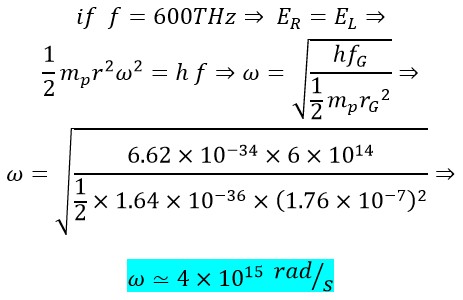
Using the obtained angular velocity, for the rotational radius of photons, we have:
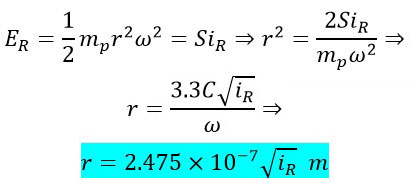
Finally, we calculate the linear and rotational velocity for the frequency f = 600 THz, where ER = EL .
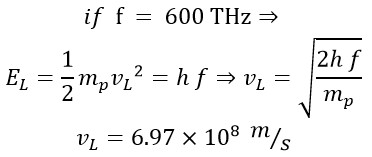
On the other hand, for the rotational speed, considering the rotational radius rG = 1.76 × 10-7 and ω = 4 × 1015 so:

Conclusion:
Equations proposed by the Saleh group present a new and more complex picture of the photon's structure—one in which helical motion, internal energies, and rotational dynamics play a central role. This innovative perspective provides a foundation for re-evaluating fundamental equations and redefining the interactions between quantum and relativistic theories, opening new horizons in theoretical physics.
References:
[1] Chandler, David L. “Breaking the Law, at the Nanoscale.” MIT News | Massachusetts Institute of Technology, news.mit.edu/2009/heat-0729 . Accessed 29 July 2009.
[2] Thompson, Dakotah, et al. " Hundred-fold enhancement in far-field radiative heat transfer over the blackbody limit. " Nature 561.7722 (2018): 216-221.
[3] Saleh, Gh. "5 Evidences that Shows the Speed of Photon Is 3.3 C." Saleh Theory, 19 Jul. 2025, https://saleh-theory.com/article/5-evidences-that-shows-the-speed-of-photon-is-33-c
[5] Saleh, Gh. "New Proof of Photon Velocity (VT = 3.3 C) Utilising Mathematical Equations, Physical Laws and the Experiments of MIT and Michigan University in the Universe 2025 Part A." Saleh Theory, 26 Apr. 2025, https://www.saleh-theory.com/article/a-new-proof-of-photon-velocity-vsubtsub-33-c-utilising-mathematical-equations-physical-laws-and-the-experiments-of-mit-and-michigan-university-in-the-universe-2025-part-a
[6] Saleh, Gh. "New Proof of Photon Velocity (VT = 3.3 C) Utilising Ever-True Planck Energy Equation and Kinetic Energy Equation in the Universe 2025 Part B." Saleh Theory, 03 May 2025, https://www.saleh-theory.com/article/a-new-proof-of-photon-velocity-vsubtsub-33-c-utilising-ever-true-planck-energy-equation-and-kinetic-energy-equation-in-the-universe-2025-part-b
[7] Saleh, Gh. "New Proof of Photon Velocity (VT = 3.3 C) Utilising the Young's Double-Slit Experiment and the Motional Model of Emitted Photons from Electrons in the Universe 2025 Part C." Saleh Theory, 03 May 2025, https://www.saleh-theory.com/article/a-new-proof-of-photon-velocity-vsubtsub-33-c-utilising-the-youngs-double-slit-experiment-and-the-motional-model-of-emitted-photons-from-electrons-in-the-universe-2025-part-c
[8] Saleh, Gh. "New Calculation of the Angular Velocity and Rotational Radius of Photons in the Universe." Saleh Theory, 28 Jun. 2024, https://saleh-theory.com/article/new-calculation-of-the-angular-velocity-and-rotational-radius-of-photons-in-the-universe
[9] Saleh, Gh. "Discovery of the Hundred-Year-Old Lost Mathematical and Physical Relationship Between the Classical Kinetic Energy of Photons and Planck's Everlasting Experimental Equation in the Universe (Planck-Saleh Energy Equation)." Saleh Theory, 28 Jun. 2024, https://www.saleh-theory.com/article/discovery-of-the-hundred-year-old-lost-mathematical-and-physical-relationship-between-the-classical-kinetic-energy-of-photons-and-plancks-everlasting-experimental-equation-in-the-universe-planck-saleh-energy-equation
[10] Saleh, Gh. "New Discoveries About the Speed of Electromagnetic Waves 2024 Part A." Saleh Theory, 12 Oct. 2023, https://www.saleh-theory.com/article/new-discoveries-about-the-speed-of-electromagnetic-waves-2024-part-a
[11] Saleh, Gh. "New Discoveries About the Speed of Electromagnetic Waves 2024 Part B." Saleh Theory, 30 Oct. 2023, https://www.saleh-theory.com/article/new-discoveries-about-the-speed-of-electromagnetic-waves-2024-part-b
[12] Saleh, Gh. "New Discoveries About the Speed of Electromagnetic Waves 2024 Part C." Saleh Theory, 06 Nov. 2023, https://www.saleh-theory.com/article/new-discoveries-about-the-speed-of-electromagnetic-waves-2024-part-c
[13] Saleh, Gh. "New Discoveries About the Speed of Electromagnetic Waves 2024 Part D." Saleh Theory, 16 Dec. 2023, https://saleh-theory.com/article/new-discoveries-about-the-speed-of-electromagnetic-waves-2024-part-d
[14] Saleh, Gh. "10 Great Reasons for Helical Motion of Photon." APS Meeting Abstracts. 2022.
[16] Saleh, Gh. "New Definition of Color Variety of Photons." Saleh Theory, 05 May. 2017, https://saleh-theory.com/article/new-definition-of-color-variety-of-photons
[17] Saleh, Gh. " A Revolution in Light Theory." Saleh Theory, 11 Apr. 2017, https://saleh-theory.com/article/a-revolution-in-light-theory
 Download PDF
Download PDF 




